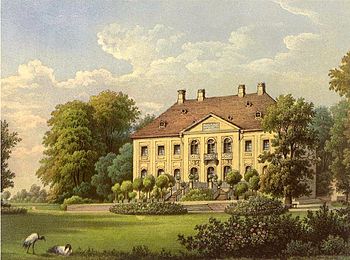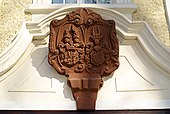Wentzky (noble family)
Wentzky also Wensky or Wentzki and Wentzky and Peter Heyde is the name of the male line extinct Silesian noble family , who in since 1965 kognatischer line whose surname Furer will continue.
history

The von Wentzky family first appeared in a document with Matthias Wencki in 1476. According to older literature, however, the established line of strains begins with Matz von Wentzky in 1346. Other older literature is derived from the old Counts of Biberstein . The family borrows its epithet from their ancestral estate Petersheide near Friedewalde in the Principality of Neisse . This came into his possession at the end of the 15th century by Katharine Adolphine von Petersheide , wife of Georg von Wentzky in Mahlendorf.
The Prince's Day of 1554 decided to have the Silesian knighthood recorded. The princely Liegnitz - Briegische councilor Georg Wentzky von Petersheyda († 1590) then wrote his treatise on the Silesian chivalric law and honorary court, an attempt to summarize and standardize the rules applicable to the nobility, which was only published in 1615.
Other estates in Silesia existed at times in Barzdorf, Beerwalde, Klein Briesen, Chursanwitz, Danchwitz , Glambach , Grünheide, Heinzendorf, Krausenau, Krippitz, Kummelwitz, Klein Lauden, Lorzendorf, Mahlendorf, Maßwitz, Mückendorf, Neusorge, Niklasdorf, Noldau, Olbendorf, Obereck , Peterwitz, Plohe, Plohmühl, Ober- and Nieder-Reichen, Rogau, Rosenau, Ruppersdorf, Sackerau, Schbrunn, Schollendorf, roast pork, Groß Schweinern, Seifersdorf, Steinersdorf, Tschanschwitz, Ulsche, Wammen and Groß Wilkawe.
When the male line of the family died out around the middle of the 20th century, Wilmar Fürer, a bank clerk in Kassel , united his name with that of Wentzky and Petersheyde zu Wentzky and Petersheyde-Fürer . The name change was authorized by decree of the Hessian Ministry of the Interior in Wiesbaden on March 4, 1965 and was not objected to by the Committee for Nobility Issues of the German Aristocratic Associations Marburg on October 10, 1966. A coats of arms union of both families took place in 1967.
coat of arms
The family coat of arms is based on the Rogala coat of arms cooperative . In black on the right an erect silver bull's horn, on the left an erect six-ended stag pole . On the helmet with black and silver covers the shield figures.
The coat of arms of Wentzky and Petersheyde-Fürer (1967) shows in black on the right an upright wisent horn (Wentzky), on the left a silver crane head with neck and torso (Fürer) turned inwards . On the helmet with black and silver covers, the bison horn on the right and a six-ended deer pole on the left.
Relatives
- Mathias von Wentzky and Petersheyde († 1560), auxiliary bishop in Breslau and governor of the principality of Neisse
- Karl Franz Neander von Petersheide (1662–1693), auxiliary bishop in Breslau and titular bishop of Nicopolis
- Albin von Wentzky (District Administrator) (1804–1849), Prussian District Administrator 1818–1848 in the Münsterberg district and 1848–1849 in the Namslau district
- Albin von Wentzky (General) (1860–1917), Prussian general of the cavalry
literature
- von Wentzky and Petersheyde . In: Marcelli Janecki , Deutsche Adelsgenossenschaft (Hrsg.): Yearbook of the German nobility . Third volume. WT Bruer's Verlag, Berlin 1899, p. 772-780 ( dlib.rsl.ru ).
-
Genealogical manual of the nobility . CA Starke Verlag, Limburg (Lahn), ISSN 0435-2408 .
- Genealogical handbook of noble houses. B 2, volume 12 of the complete series, 1956, pp. 512-515; B 8, volume 41 of the complete series, 1968, pp. 451-453.
- Nobility Lexicon. Volume XVI, Volume 137 of the complete series, 2005, p. 89; Volume XVII, Volume 144 of the complete series, 2008, p. 534.
- Genealogical paperback of the knight and noble families. Volume 5, Brünn 1880, pp. 491-501 ( digital.ub.uni-duesseldorf.de ).
-
Gothaischer Hofkalender . Justus Perthes, Gotha
- Gothaisches genealogical pocket book of the noble houses , A 1900; 1902, pp. 882-884 ( digital.ub.uni-duesseldorf.de ); 1904, pp. 886-888 ( digital.ub.uni-duesseldorf.de ); 1906, pp. 843-845 ( digital.ub.uni-duesseldorf.de ).
- Gothaisches genealogical pocket book of the letter aristocratic houses. B 1922, 1928, 1933, 1936, 1940.
- Leopold von Ledebur : Adelslexicon of the Prussian monarchy . Volume 3, Berlin 1858, p. 100 ( reader.digitale-sammlungen.de ).
- Friedrich Lucae : Silesia's curious memorabilia or perfect chronicle. Frankfurt a. M. 1689, p. 1862 ( books.google.de ).
- Karl Friedrich Pauli : Life of great heroes of the current war. Volume 3, Halle 1759, pp. 189-236 ( books.google.de ).
- Bernhard W. Scholz: The spiritual principality Neisse. Böhlau Verlag Cologne Weimar Vienna 2011, ISBN 978-3-412-20628-4 , p. 336 f. ( books.google.de )
- Johann Sinapius : Silesian Curiosities First Presentation, Inside the handsome families of the Silesian nobility. Leipzig 1720 pp. 1026-1028, ( books.google.de ).
- Leopold von Zedlitz-Neukirch : New Prussian Adelslexicon . Volume 4, Leipzig 1837, pp. 324-325 ( books.google.de ).
- Friedrich Albert Zimmermann : Collected news from the noble family v. Wentzky. Wroclaw 1803.
Web links
- Genealogy on the website of Sonja v. Wentzky and Petersheyde-Fürer
Individual evidence
- ↑ George Thebesius : Lignitzer Yearbooks 2, Jawor 1736 S. 356th
- ↑ Jakob Christoph Iselin , Jakob Christoph Beck, August Johann Burtorff: Newly augmented historical and geographic general lexicon. Volume 6, Basel 1744, p. 1031 ( books.google.de ).
- ↑ Georg von Wentzky and Petersheyde, Kurtzer Tractat and report from the Silesian Knight Law and Honor Court ( europeana.eu ).
- ^ Jan Harasimowicz and Matthias Weber (eds.): Adel in Schlesien. Volume 1: Rule - Culture - Self-Presentation. Munich 2010, p. 18 ( books.google.de )
- ↑ Bernhard W. Scholz: The spiritual principality of Neisse: a rural elite under the rule of the bishop (1300-1650). 2011, p. 336 books.google.de


